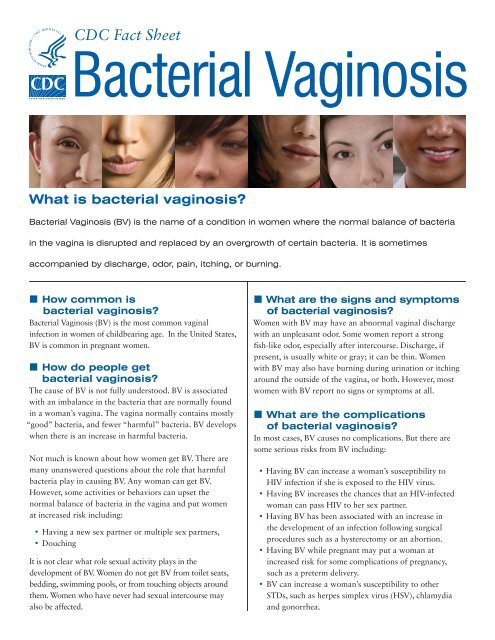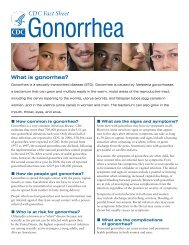Bacterial Vaginosis Fact Sheet
Bacterial Vaginosis Fact Sheet
Bacterial Vaginosis Fact Sheet
Create successful ePaper yourself
Turn your PDF publications into a flip-book with our unique Google optimized e-Paper software.
CDC <strong>Fact</strong> <strong>Sheet</strong><br />
<strong>Bacterial</strong> <strong>Vaginosis</strong><br />
What is bacterial vaginosis?<br />
<strong>Bacterial</strong> <strong>Vaginosis</strong> (BV) is the name of a condition in women where the normal balance of bacteria<br />
in the vagina is disrupted and replaced by an overgrowth of certain bacteria. It is sometimes<br />
accompanied by discharge, odor, pain, itching, or burning.<br />
g How common is<br />
bacterial vaginosis?<br />
<strong>Bacterial</strong> <strong>Vaginosis</strong> (BV) is the most common vaginal<br />
infection in women of childbearing age. In the United States,<br />
BV is common in pregnant women.<br />
g How do people get<br />
bacterial vaginosis?<br />
The cause of BV is not fully understood. BV is associated<br />
with an imbalance in the bacteria that are normally found<br />
in a woman’s vagina. The vagina normally contains mostly<br />
“good” bacteria, and fewer “harmful” bacteria. BV develops<br />
when there is an increase in harmful bacteria.<br />
Not much is known about how women get BV. There are<br />
many unanswered questions about the role that harmful<br />
bacteria play in causing BV. Any woman can get BV.<br />
However, some activities or behaviors can upset the<br />
normal balance of bacteria in the vagina and put women<br />
at increased risk including:<br />
• Having a new sex partner or multiple sex partners,<br />
• Douching<br />
It is not clear what role sexual activity plays in the<br />
development of BV. Women do not get BV from toilet seats,<br />
bedding, swimming pools, or from touching objects around<br />
them. Women who have never had sexual intercourse may<br />
also be affected.<br />
g What are the signs and symptoms<br />
of bacterial vaginosis?<br />
Women with BV may have an abnormal vaginal discharge<br />
with an unpleasant odor. Some women report a strong<br />
fish-like odor, especially after intercourse. Discharge, if<br />
present, is usually white or gray; it can be thin. Women<br />
with BV may also have burning during urination or itching<br />
around the outside of the vagina, or both. However, most<br />
women with BV report no signs or symptoms at all.<br />
g What are the complications<br />
of bacterial vaginosis?<br />
In most cases, BV causes no complications. But there are<br />
some serious risks from BV including:<br />
• Having BV can increase a woman’s susceptibility to<br />
HIV infection if she is exposed to the HIV virus.<br />
• Having BV increases the chances that an HIV-infected<br />
woman can pass HIV to her sex partner.<br />
• Having BV has been associated with an increase in<br />
the development of an infection following surgical<br />
procedures such as a hysterectomy or an abortion.<br />
• Having BV while pregnant may put a woman at<br />
increased risk for some complications of pregnancy,<br />
such as a preterm delivery.<br />
• BV can increase a woman’s susceptibility to other<br />
STDs, such as herpes simplex virus (HSV), chlamydia<br />
and gonorrhea.
g How does bacterial vaginosis<br />
affect a pregnant woman and<br />
her baby?<br />
Pregnant women with BV more often have babies who are<br />
born premature or with low birth weight (low birth weight<br />
is less than 5.5 pounds).<br />
The bacteria that cause BV can sometimes infect the uterus<br />
(womb) and fallopian tubes (tubes that carry eggs from the<br />
ovaries to the uterus). This type of infection is called pelvic<br />
inflammatory disease (PID). PID can cause infertility or<br />
damage the fallopian tubes enough to increase the future<br />
risk of ectopic pregnancy and infertility. Ectopic pregnancy<br />
is a life-threatening condition in which a fertilized egg grows<br />
outside the uterus, usually in a fallopian tube which can rupture.<br />
g How is bacterial vagnosis<br />
diagnosed?<br />
A health care provider must examine the vagina for signs of<br />
BV and perform laboratory tests on a sample of vaginal fluid<br />
to look for bacteria associated with BV.<br />
g What is the treatment for<br />
bacterial vagnosis?<br />
Although BV will sometimes clear up without treatment,<br />
all women with symptoms of BV should be treated to avoid<br />
complications. Male partners generally do not need to be<br />
treated. However, BV may spread between female sex partners.<br />
Treatment is especially important for pregnant women.<br />
All pregnant women who have ever had a premature delivery<br />
or low birth weight baby should be considered for a BV<br />
examination, regardless of symptoms, and should be treated<br />
if they have BV. All pregnant women who have symptoms<br />
of BV should be checked and treated.<br />
Some physicians recommend that all women undergoing<br />
a hysterectomy or abortion be treated for BV prior to the<br />
procedure, regardless of symptoms, to reduce their risk<br />
of developing an infection.<br />
BV is treatable with antibiotics prescribed by a health care<br />
provider. Two different antibiotics are recommended as<br />
treatment for BV: metronidazole or clindamycin. Either can<br />
be used with non-pregnant or pregnant women, but the<br />
recommended dosages differ. Women with BV who are<br />
HIV-positive should receive the same treatment as those<br />
who are HIV-negative.<br />
BV can recur after treatment.<br />
g How can bacterial vagnosis<br />
be prevented?<br />
BV is not completely understood by scientists, and the best<br />
ways to prevent it are unknown. However, it is known that<br />
BV is associated with having a new sex partner or having<br />
multiple sex partners.<br />
The following basic prevention steps can help reduce the risk<br />
of upsetting the natural balance of bacteria in the vagina<br />
and developing BV:<br />
• Be abstinent.<br />
• Limit the number of sex partners.<br />
• Do not douche.<br />
• Use all of the medicine prescribed for treatment of BV,<br />
even if the signs and symptoms go away.<br />
g FOR MORE INFORMATION:<br />
Division of STD Prevention (DSTDP)<br />
Centers for Disease Control and Prevention<br />
www.cdc.gov/std<br />
Order Publication Online at www.cdc.gov/std/pub<br />
CDC-INFO Contact Center<br />
1-800-CDC-INFO (1-800-232-4636)<br />
Email: cdcinfo@cdc.gov<br />
Website: www.cdc.gov<br />
CDC National Prevention Information Network (NPIN)<br />
P.O. Box 6003<br />
Rockville, MD 20849-6003<br />
1-800-458-5231<br />
1-888-282-7681 Fax<br />
1-800-243-7012 TTY<br />
E-mail: info@cdcnpin.org<br />
www.cdcnpin.org<br />
CS115145<br />
CONTENT UPDATED: DECEMBER, 2007

















